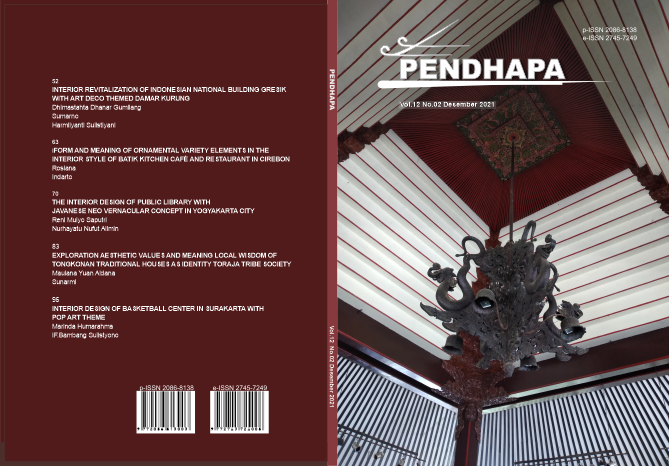Interior Design of Basketball Center in Surakarta with Pop Art Theme
DOI:
https://doi.org/10.33153/pendhapa.v12i2.3508Keywords:
Basketball Center, Pop Art, Sports, Design InteriorAbstract
Basketball Center Interior Design in Surakarta with Pop Art Theme aims to (1) Create an interior design of sports hall that is able to attract the attention of the public in exercising and maintaining health. (2) Create a basketball centre that can increase the passion for exercising while practising or competing through the atmosphere. The methods used in this study are programming that includes library studies, surveys, interviews. Then data analysis, idea development, and design methods. From this analysis can be summed up several things: (1) Basketball centre interior design as a physical fitness centre and a container of sports activities especially basketball sports designed to influence the psychology of players. (2) Shapes, colours and materials applied according to the theme namely pop art on all interior elements. (3) The atmosphere of the room that is raised is a cosy, cheerful, unique, interesting, free, and limitless atmosphere
Downloads
References
Boniface, P. (2017). Tasting tourism: Travelling for food and drink. Routledge.
Brochu, E. (n.d.). Easter Coloring Pages, 40 Printable Easter Coloring Pages for Kids, Boys, Girls, Teens, Easter Egg Hunt, Rabbit/Bunny, Easter Party Activity.
Chen, T.-L., Chen, J. C., Huang, C.-F., & Chang, P.-C. (2021). Solving the layout design problem by simulation-optimization approach–A case study on a sortation conveyor system. Simulation Modelling Practice and Theory, 106, 102192. https://doi.org/10.1016/j.simpat.2020.102192
Chou, J.-S., & Truong, D.-N. (2020). Multiobjective optimization inspired by behavior of jellyfish for solving structural design problems. Chaos, Solitons & Fractals, 135, 109738. https://doi.org/10.1016/j.chaos.2020.109738
Dodds, K., & Funnell, L. (2020). Popular Culture. In International Encyclopedia of Human Geography (pp. 223–228). Elsevier. https://doi.org/10.1016/B978-0-08-102295-5.10854-6
Dong, X., Wu, Y., Chen, X., Li, H., Cao, B., Zhang, X., Yan, X., Li, Z., Long, Y., & Li, X. (2021). Effect of thermal, acoustic, and lighting environment in underground space on human comfort and work efficiency: A review. Science of The Total Environment, 786, 147537. https://doi.org/10.1016/j.scitotenv.2021.147537
Ferkel, R. C., Judge, L. W., Stodden, D. F., & Griffin, K. (2014). Importance of health-related fitness knowledge to increasing physical activity and physical fitness. Physical Educator, 71(2), 218.
Gois, M. de O., Simões, R. P., Porta, A., Kunz, V. C., Pastre, C. M., & Catai, A. M. (2020). Cardiovascular responses to low-intensity isometric handgrip exercise in coronary artery disease: effects of posture. Brazilian Journal of Physical Therapy, 24(5), 449–457. https://doi.org/10.1016/j.bjpt.2019.07.010
Hadjarati, H. (2009). Memberdayakan olah raga nasional. Jurnal Pelangi Ilmu, 2(5).
Knarud, J. I., Geving, S., & Kvande, T. (2021). Moisture performance of interior insulated brick wall segments subjected to wetting and drying – A laboratory investigation. Building and Environment, 188, 107488. https://doi.org/10.1016/j.buildenv.2020.107488
Liang, G. (1976). Garis Besar Estetika (Filsafat Keindahan). Yogyakarta: Pusat Ilmu Berguna.
Minguez Garcia, B. (2021). Integrating culture in post-crisis urban recovery: Reflections on the power of cultural heritage to deal with crisis. International Journal of Disaster Risk Reduction, 60, 102277. https://doi.org/10.1016/j.ijdrr.2021.102277
nblindonesia. (2012). Penonton NBL Tumbuh 50 PersenNo Title. PT. DBL Indonesia.
Olofsson, E., & Sjolen, K. (2006). Design Sketching.pdf (2nd ed.). KEEOS Design Book.
Sachari, A. (2008). Metode Penelitian Budaya Rupa. Erlangga.
Shadrina, R. (2018). Kontestasi Politik Ruang (Studi Atas keberadaan Mushola Khusus Perempuan di Kauman).
Suptandar, J. P. (1982). Perancangan Tata Ruang Dalam (Interior Design). Penerbit PT Djambatan.
Widyokusumo, L. (2013). Fungsi Garis pada Desain dan Sketsa. Humaniora, 4(1), 339–347.
Downloads
Published
Issue
Section
License
Authors who publish with Pendhapa agree to the following terms:
- Authors retain copyright and grant the journal right of first publication with the work simultaneously licensed under a Creative Commons Attribution License (CC BY-SA 4.0) that allows others to share the work with an acknowledgment of the work's authorship and initial publication in this journal.
- Authors are able to enter into separate, additional contractual arrangements for the non-exclusive distribution of the journal's published version of the work (e.g., post it to an institutional repository or publish it in a book), with an acknowledgment of its initial publication in this journal.
- Authors are permitted and encouraged to post their work online (e.g., in institutional repositories or on their website) prior to and during the submission process, as it can lead to productive exchanges, as well as earlier and greater citation of published work.

This work is licensed under a Creative Commons Attribution-ShareAlike 4.0 International License.









